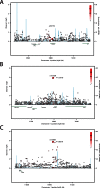Interrogation of the platelet-derived growth factor receptor alpha locus and corneal astigmatism in Australians of Northern European ancestry: results of a genome-wide association study
- PMID: 23761726
- PMCID: PMC3675057
Interrogation of the platelet-derived growth factor receptor alpha locus and corneal astigmatism in Australians of Northern European ancestry: results of a genome-wide association study
Abstract
Purpose: Corneal astigmatism is a common eye disorder characterized by irregularities in corneal curvature. Recently, the rs7677751 single nucleotide polymorphism (SNP) at the platelet-derived growth factor receptor alpha (PDGFRA) locus was found to be associated with corneal astigmatism in people of Asian ancestry. In the present study, we sought to replicate this finding and identify other genetic markers of corneal astigmatism in an Australian population of Northern European ancestry.
Methods: Data from two cohorts were included in this study. The first cohort consisted of 1,013 individuals who were part of the Western Australian Pregnancy Cohort (Raine) Study: 20-year follow-up Eye Study. The second cohort comprised 1,788 individuals of 857 twin families who were recruited through the Twins Eye Study in Tasmania and the Brisbane Adolescent Twin Study. Corneal astigmatism was calculated as the absolute difference between the keratometry readings in two meridians, and genotype data were extracted from genome-wide arrays. Initially, each cohort was analyzed separately, before being combined for meta- and subsequent genome-wide pathway analysis.
Results: Following meta-analysis, SNP rs7677751 at the PDGFRA locus had a combined p=0.32. No variant was found to be statistically significantly associated with corneal astigmatism at the genome-wide level (p<5.0×10(-8)). The SNP with strongest association was rs1164064 (p=1.86×10(-6)) on chromosome 3q13. Gene-based pathway analysis identified a significant association between the Gene Ontology "segmentation" (GO:0035282) pathway, corrected p=0.009.
Conclusions: Our data suggest that the PDGFRA locus does not transfer a major risk of corneal astigmatism in people of Northern European ancestry. Better-powered studies are required to validate the novel putative findings of our study.
Figures



Similar articles
-
A genome-wide association study for corneal curvature identifies the platelet-derived growth factor receptor α gene as a quantitative trait locus for eye size in white Europeans.Mol Vis. 2013;19:243-53. Epub 2013 Jan 3. Mol Vis. 2013. PMID: 23401653 Free PMC article.
-
A genome-wide association study of corneal astigmatism: The CREAM Consortium.Mol Vis. 2018 Feb 5;24:127-142. eCollection 2018. Mol Vis. 2018. PMID: 29422769 Free PMC article.
-
Genome-wide meta-analysis of five Asian cohorts identifies PDGFRA as a susceptibility locus for corneal astigmatism.PLoS Genet. 2011 Dec;7(12):e1002402. doi: 10.1371/journal.pgen.1002402. Epub 2011 Dec 1. PLoS Genet. 2011. PMID: 22144915 Free PMC article.
-
Genetic variants near PDGFRA are associated with corneal curvature in Australians.Invest Ophthalmol Vis Sci. 2012 Oct 11;53(11):7131-6. doi: 10.1167/iovs.12-10489. Invest Ophthalmol Vis Sci. 2012. PMID: 22969067 Free PMC article.
-
Genome-wide association studies for corneal and refractive astigmatism in UK Biobank demonstrate a shared role for myopia susceptibility loci.Hum Genet. 2018 Dec;137(11-12):881-896. doi: 10.1007/s00439-018-1942-8. Epub 2018 Oct 10. Hum Genet. 2018. PMID: 30306274 Free PMC article.
Cited by
-
Analysis combining correlated glaucoma traits identifies five new risk loci for open-angle glaucoma.Sci Rep. 2018 Feb 15;8(1):3124. doi: 10.1038/s41598-018-20435-9. Sci Rep. 2018. PMID: 29449654 Free PMC article.
-
Integrated analysis of long non-coding RNAs (lncRNAs) and mRNA expression profiles identifies lncRNA PRKG1-AS1 playing important roles in skeletal muscle aging.Aging (Albany NY). 2021 May 29;13(11):15044-15060. doi: 10.18632/aging.203067. Epub 2021 May 29. Aging (Albany NY). 2021. PMID: 34051073 Free PMC article.
-
Genetics of neurosarcoidosis.J Neuroimmunol. 2022 Nov 15;372:577957. doi: 10.1016/j.jneuroim.2022.577957. Epub 2022 Aug 29. J Neuroimmunol. 2022. PMID: 36054933 Free PMC article. Review.
-
HGF-rs12536657 and Ocular Biometric Parameters in Hyperopic Children, Emmetropic Adolescents, and Young Adults: A Multicenter Quantitative Trait Study.J Ophthalmol. 2019 Feb 3;2019:7454250. doi: 10.1155/2019/7454250. eCollection 2019. J Ophthalmol. 2019. PMID: 30863626 Free PMC article.
-
Association of PDGFRA polymorphisms with the risk of corneal astigmatism in a Japanese population.Sci Rep. 2023 Sep 26;13(1):16075. doi: 10.1038/s41598-023-43333-1. Sci Rep. 2023. PMID: 37752244 Free PMC article.
References
-
- Wong TY, Foster PJ, Hee J, Ng TP, Tielsch JM, Chew SJ, Johnson GJ, Seah SK. Prevalence and risk factors for refractive errors in adult Chinese in Singapore. Invest Ophthalmol Vis Sci. 2000;41:2486–94. - PubMed
-
- Wu HM, Seet B, Yap EP, Saw SM, Lim TH, Chia KS. Does education explain ethnic differences in myopia prevalence? A population-based study of young adult males in Singapore. Optom Vis Sci. 2001;78:234–9. - PubMed
-
- Raju P, Ramesh SV, Arvind H, George R, Baskaran M, Paul PG, Kumaramanickavel G, McCarty C, Vijaya L. Prevalence of refractive errors in a rural South Indian population. Invest Ophthalmol Vis Sci. 2004;45:4268–72. - PubMed
-
- Hashemi H, Hatef E, Fotouhi A, Mohammad K. Astigmatism and its determinants in the Tehran population: the Tehran eye study. Ophthalmic Epidemiol. 2005;12:373–81. - PubMed
-
- Attebo K, Ivers RQ, Mitchell P. Refractive errors in an older population: the Blue Mountains Eye Study. Ophthalmology. 1999;106:1066–72. - PubMed
Publication types
MeSH terms
Substances
Grants and funding
LinkOut - more resources
Full Text Sources
Miscellaneous
